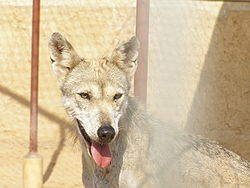Arabian wolf: Difference between revisions
Barticus88 (talk | contribs) m red link Paul C. Paquet |
No edit summary |
||
| Line 59: | Line 59: | ||
[[fi:Arabiansusi]] |
[[fi:Arabiansusi]] |
||
[[sv:Arabisk varg]] |
[[sv:Arabisk varg]] |
||
[[zh:阿拉伯狼]] |
|||
Revision as of 02:18, 3 January 2009
| Arabian Wolf | |
|---|---|

| |
| Scientific classification | |
| Kingdom: | |
| Phylum: | |
| Class: | |
| Order: | |
| Family: | |
| Genus: | |
| Species: | |
| Subspecies: | C. l. arabs
|
| Trinomial name | |
| Canis lupus arabs | |
| File:Present distribution of wolf subspecies arab.JPG | |
| Arabian wolf range | |
The Arabian wolf (Canis lupus arabs) is a subspecies of Gray Wolf which was once found throughout the Arabian Peninsula, but now only lives in small pockets in Southern Israel, Oman, Yemen, Jordan, Saudi Arabia, and probably in some parts of the Sinai Peninsula in Egypt.
Features and adaptations
The Arabian wolf is a small, desert adapted wolf that stands at around 26 inches shoulder height and weighs an average of 40 pounds Their ears are proportionally larger in relation to body size when compared to other species, an adaptation needed to disperse body heat. Also, Arabian wolves do not live in large packs, and instead hunt in pairs or in groups of about three to four animals. This subspecies is unusual, as it is not known to howl.[2]. Arabian wolves have short, thin fur in summer, though the hair on their back remains long even in summer. It is thought that this is an adaptation against solar radiation. The winter coat is long, though not as long as northern subspecies.[3] Arabian wolves are unique among grey wolves due to the middle two toes of their paws being fused, a trait originally thought unique to the African Wild Dog.[4] Like other wolves, the Arabian wolf's eyes are yellow, but many are found with brown eyes — a certain indication that a portion of the population is not of pure blood anymore and that their ancestors have interbred with feral dogs. This poses a very serious threat to the survival of this subspecies.[verification needed][citation needed]
It is distinguished from the Iranian Wolf by its paler fur, smaller size and proportionally smaller head.[5]
Diet

Arabian wolves will attack and eat any domestic animal up to the size of a goat. As a result, farmers will not hesitate to shoot, poison, or trap them. Arabian wolves also feed on hares, rodents, ungulates, and any carrion they can find.
Arabian wolves will hunt small to medium sized animals such as cape hares, Dorcas Gazelles and ibexes, though they will feed on carrion and livestock when in the vicinity of human settlements.[6]
Current status
In Oman, the wolf population has increased significantly since hunting was banned, and there is a strong possibility that they will naturally reestablish themselves in certain places within the region in the relatively near term. In Israel, there are between 100 and 150 Arabian wolves all over the Negev and the Ha'arava.
In culture
The wolf was frequently mentioned in the Scriptures as an enemy to flocks (Sirach 13:21; Matthew 7:15), and an emblem of treachery and ferocity, and bloodthirstiness. The tribe of Benjamin, owing to its warlike character, was often compared to a wolf in the Old and New Testament of the Bible.
References
- ^ "Canis lupus arabs". Integrated Taxonomic Information System. 27 October.
{{cite web}}: Check date values in:|date=and|year=/|date=mismatch (help) - ^ Lopez, Barry (1978). Of wolves and men. p. 320. ISBN 0743249364.
- ^ Fred H. Harrington, Paul C. Paquet (1982). Wolves of the World: Perspectives of Behavior, Ecology, and Conservation. p. 474. ISBN 0815509057.
- ^ Macdonald, David (1992). The Velvet Claw. p. 256. ISBN 0563208449.
- ^ Bright, Michael (2006). Beasts of the Field: The Revealing Natural History of Animals in the Bible. p. 346. ISBN 1861058314.
- ^ "Group Size and Home Range of the Arabian Wolf (Canis lupus) in Southern Israel". American Society of Mammalogists. JSTOR. Retrieved 2007-09-02.
